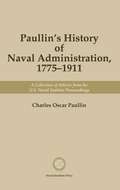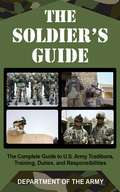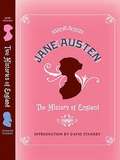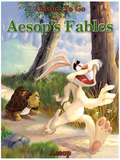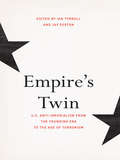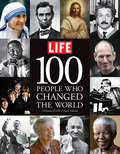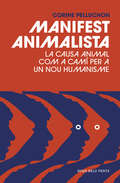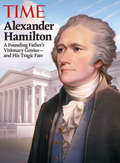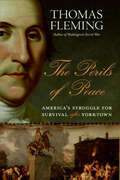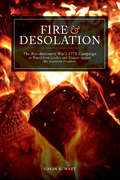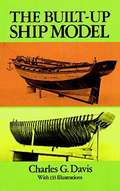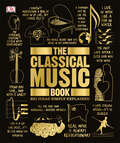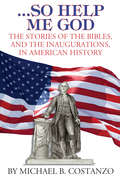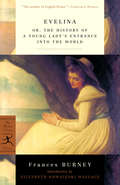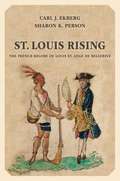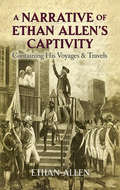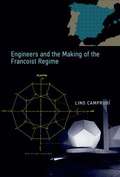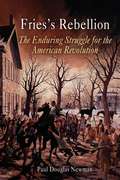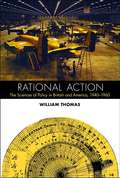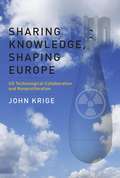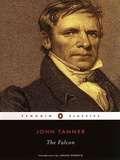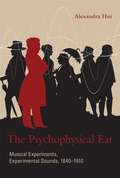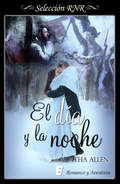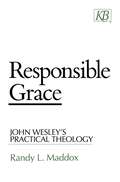- Table View
- List View
Paullin's History of Naval Administration 1775-1911
by Charles Oscar PaullinThe classic collection of articles from the U.S. Naval Institute Proceedings, now in ebook form.
The Soldier's Guide: The Complete Guide to U.S. Army Traditions, Training, and Responsibilities
by ArmyThis manual condenses important information from a number of U.S. Army regulations, field manuals, and other publications into one crucial volume. Written to answer the many questions asked by soldiers of all ranks in the Army, it covers everything from the history and traditions of the American military to training and service benefits. Find out about such ideals as "The Warrior Ethos" that drive soldiers during a mission and the Army's values of loyalty, duty, respect, selfless service, honor, integrity, personal courage, and discipline. In addition, sections cover ethical reasoning, the basic principles of war, military courtesies, individual combat skills, and more.
Two Histories of England
by Charles Dickens Jane AustenIn these two forgotten gems of English literature, Jane Austen and Charles Dickens offer delightful, irreverent histories of their native land. When she was only sixteen years old, Jane Austen composed her bitingly satirical History of England for performance in her family's drawingroom. A startling and precocious example of her celebrated wit-not to mention a brilliant social commentary-this lively piece sweeps rapidly across almost four centuries of British monarchy. In rambunctious and wickedly funny prose, Austen's critique spans from Henry IV to Charles I, from Richard III to Mary Queen of Scots, offering a fierce parody of the kind of biased history that young ladies of Austen's time were being forced to study. Reproduced here in its entirety, this is a rare, tantalizing look at the great novelist's budding talent, and an extraordinary bit of literary history that lay unpublished for more than 130 years. Charles Dickens's A Child's History of England, by contrast, was written and published at the height of its author's considerable fame. A gory and dramatic account, full of villains and heroes, the essay was originally intended as a study-piece for his children, but in fact represented a sly, unconventional countertext to the more straitlaced historical canon. Dickens's exciting, flamboyant narrative is hugely evocative, both of the history he describes and of the time in which he himself was writing. With an insightful introduction by bestselling historian David Starkey, Two Histories of England brings together, in a single, irresistible volume, these remarkable-and remarkably overlooked-literary treasures by two of the world's most beloved writers.
Aesop's Fables - Translated by George Fyler Townsend: Translated By George Fyler Townsend (1887). Illustrated By Harrison Weir, John Tenniel, Ernest Griset And Others (Classics To Go)
by AesopAesop's Fables is a collection of fables credited to Aesop, a slave and story-teller believed to have lived in ancient Greece between 620 and 560 BCE. Of diverse origins, the stories associated with Aesop's name have descended to modern times through a number of sources. They continue to be reinterpreted in different verbal registers and in popular as well as artistic mediums.
Empire’s Twin: U.S. Anti-imperialism from the Founding Era to the Age of Terrorism
by Jay Sexton Ian TyrrellAcross the course of American history, imperialism and anti-imperialism have been awkwardly paired as influences on the politics, culture, and diplomacy of the United States. The Declaration of Independence, after all, is an anti-imperial document, cataloguing the sins of the metropolitan government against the colonies. With the Revolution, and again in 1812, the nation stood against the most powerful empire in the world and declared itself independent. As noted by Ian Tyrrell and Jay Sexton, however, American "anti-imperialism was clearly selective, geographically, racially, and constitutionally." Empire's Twin broadens our conception of anti-imperialist actors, ideas, and actions; it charts this story across the range of American history, from the Revolution to our own era; and it opens up the transnational and global dimensions of American anti-imperialism. By tracking the diverse manifestations of American anti-imperialism, this book highlights the different ways in which historians can approach it in their research and teaching. The contributors cover a wide range of subjects, including the discourse of anti-imperialism in the Early Republic and Civil War, anti-imperialist actions in the U.S. during the Mexican Revolution, the anti-imperial dimensions of early U.S. encounters in the Middle East, and the transnational nature of anti-imperialist public sentiment during the Cold War and beyond. Contributors: Laura Belmonte, Oklahoma State University; Robert Buzzanco, University of Houston; Julian Go, Boston University; Alan Knight, University of Oxford; Ussama Makdisi, Rice University; Erez Manela, Harvard University; Peter Onuf, Robert H. Smith International Center for Jefferson Studies, Monticello, and University of Virginia; Jeffrey Ostler, University of Oregon; Patricia Schechter, Portland State University; Jay Sexton, University of Oxford; Ian Tyrrell, University of New South Wales
LIFE 100 People Who Changed the World
by Editors of LifeHere is a book that will surely spark a lively debate. Who are the hundred most influential religious and political leaders, artists, scientists, and adventurers of all time? How is it even possible to construct such a list? Now, the editors of LIFE comb history, compare notes and dive in. Find out who makes the cut: King Tut or Cleopatra? Thomas Jefferson or George Washington; The Rolling Stones or The Beatles; Steve Jobs or Bill Gates. This is a look at history told through its most charismatic and fascinating characters. It is also full of fun facts, tidbits, arguments and rarely seen pictures, and will appeal to curious minds, young and old alike.
Manifest animalista: La causa animal com a camí per a un nou humanisme
by Corine PelluchonLa violència contra els animals és un atac directe a la nostra humanitat. Això demostra Corine Pelluchon en aquest breu, pragmàtic, i controvertit assaig que suposa una contribució radical a l'ètica i la filosofia política. Lluitar contra el maltractament animal és rebel·lar-se contra una societat basada en l'explotació, i per això la causa animalista és una qüestió política major que ens concerneix a tots, més enllà d'ideologies o conflictes d'interessos. Amb un estil viu, persuasiu i inspirador, l'autora proposa un camí possible i factible per portar aquest debat a l'esfera política amb tanta claredat i urgència com sigui possible. Ressenyes:«Corine Pelluchon ho explica tot absolutament bé en tot just un centenar de pàgines: per ser una alternativa vàlida, és imprescindible polititzar la causa animal.»Luce Lapin, Charlie Hebdo «L'objectiu principal de l'autora està completament assolit en aquest Manifest animalista: dóna al lector les claus que li permetran ampliar el radi d'acció de l'humanisme als animals.»Philippe Douroux, Libération «Una perspectiva bella i ambiciosa.»Isabelle Gravillon, Femme Majuscule «Un llibre d'intervenció política, tan compromès com lúcid.»Robert Jules, La Tribune «Una de les moltes i grans qualitats d'aquest Manifest animalista és que, en tot moment, el seu projecte està exposat de manera perfectament creïble i realitzable. Precisament per això, l'autora no es fa cap il·lusió sobre la dificultat que suposa introduir la qüestió animal en el debat polític.»Hicham-Stéphane Afeissa, Non Fiction
TIME Alexander Hamilton: A Founding Father's Visionary Genius and His Tragic Fate
by Editors of TIMELong considered the forgotten founding father and primarily known for the duel with Aaron Burr that ended his life, Alexander Hamilton has recently achieved a new level of fame because of the hit Broadway musical Hamilton, inspired by the New York Times best-selling biography by acclaimed historian Ron Chernow.Now the editors of TIME present this special edition that celebrates Hamilton and his many accomplishments: as one of the primary architects of the Constitution, an aide and counsel to General George Washington, and the first secretary of the Treasury, as well as his intense, long-standing rivalry with Thomas Jefferson and how it affects our government to this day. Also included in this fully illustrated edition are "Six Things You Didn't Know About Alexander Hamilton," an interview with Chernow, the making of the Broadway musical, why Hamilton's days on the $10 bill are numbered, and much more.TIME brings keen insight to the improbable life of the illegitimate son of a Caribbean merchant who would go on to help shape our nation, lay the foundation for the modern economy, and become the inspiration for a musical that is inspiring Americans to interpret history in an entirely new way.
The Perils of Peace: America's Struggle for Survival After Yorktown
by Thomas FlemingThe acclaimed historian presents a “captivating account of a surprisingly little-known period” at the close of the American Revolution (Kirkus, starred review).On October 19, 1781, Great Britain’s best army surrendered to General George Washington at Yorktown. But the future of the thirteen former colonies was far from clear. 13,000 British troops still occupied New York City, and another 13,000 regulars and armed loyalists were scattered from Canada to Georgia. Meanwhile, the American army had not been paid for years and was on the brink of mutiny.In Europe, America’s only ally, France, teetered on the verge of bankruptcy and was soon reeling from a disastrous naval defeat in the Caribbean. A stubborn George III dismissed Yorktown as a minor defeat and refused to yield an acre of “my dominions” in America. In Paris, Ambassador Benjamin Franklin confronted violent hostility toward France among his fellow members of the American peace delegation.In The Perils of Peace, Thomas Fleming moves between the key players in this drama and shows that the outcome we take for granted was far from certain. With fresh research and masterful storytelling, Fleming breathes new life into this tumultuous but little known period in America’s history.
Fire and Desolation: The Revolutionary War's 1778 Campaign as Waged from Quebec and Niagara Against the American Frontiers
by Gavin K. WattFollowing a disastrous campaign in 1777, the alliance between the Six Nations and the British Crown became seriously strained. Relations were made even more difficult by the hands-off stance of Quebec’s governor, General Guy Carleton, which led to the Native leaders developing their own strategies and employing traditional tactics, leading to a ferocious series of attacks on the frontiers of Vermont, New York, and Pennsylvania, supported by Loyalist and Regular troops. Among these were two infamous actions, referred to as “massacres” by American historians — attacks on the Wyoming and Cherry Valleys. This destructive campaign prompted the Continental Congress to mount three major retributive expeditions against the territories of the Six Nations and their allies the following year. In Fire and Desolation, Gavin Watt details individual historical conflicts, illustrates the crushing tactical expertise of the Senecas and their Loyalist allies, and provides a fresh perspective on Canada’s involvement in the American Revolution and the unfolding events of 1778.
The Built-Up Ship Model
by Charles G. DavisThis highly detailed, superbly illustrated manual introduces serious model builders to the hand crafting of ship models from the bottom up, exactly as real ships were traditionally built in shipyards. Clearly, and with painstaking care, every step of construction is explained, from laying the keel to the last details of masting and rigging.For this book, the author chose as a model the 16-gun United States brig Lexington, a merchant vessel converted to military use in 1773, and a veteran of two years of active service in the Revolution. To ensure complete accuracy and to alert readers to possible problems and pitfalls along the way, the author, a naval architect and master model builder, constructed the model as he wrote the book.Photographs illustrate the day-to-day work in progress, so that ship model builders can check their work against Davis's own replica. In addition, over 100 drawings show in detail correct implementation of the more complex instructions. In his introduction, Charles Davis chronicles the exciting career of the Lexington, and the role it played in America's fight for freedom.A classic in its field, The Built-Up Ship Model is not a book for beginners; rather, it is an expert guide aimed at model builders with experience, patience, and a passion for building "the real thing." The reward: an heirloom-quality ship model as beautiful as it is authentic in every detail.
The Classical Music Book: Big Ideas Simply Explained (DK Big Ideas)
by DKLearn about the world&’s greatest classical compositions and musical traditions in The Classical Music Book.Part of the fascinating Big Ideas series, this book tackles tricky topics and themes in a simple and easy to follow format. Learn about Classic Music in this overview guide to the subject, great for novices looking to find out more and experts wishing to refresh their knowledge alike! The Classical Music Book brings a fresh and vibrant take on the topic through eye-catching graphics and diagrams to immerse yourself in. This captivating book will broaden your understanding of Classical Music, with:- More than 90 pieces of world-famous music - Packed with facts, charts, timelines and graphs to help explain core concepts- A visual approach to big subjects with striking illustrations and graphics throughout- Easy to follow text makes topics accessible for people at any level of understandingThe Classical Music Book is a captivating introduction to music theory, crucial composers and the impact of seminal pieces, aimed at adults with an interest in the subject and students wanting to gain more of an overview. Here you&’ll discover more than 90 works by famous composers from the early period to the modern day, through exciting text and bold graphics.Your Classical Music Questions, Simply ExplainedFrom Mozart to Mendelssohn, this fresh new guide goes beyond your typical music books, offering a comprehensive overview to classical music history and biography. If you thought it was difficult to learn about music theory, The Classical Music Book presents key information in an easy to follow layout. Explore the main ideas underpinning the world&’s greatest compositions and musical traditions, and define their importance to the musical canon and into their wider social, cultural, and historical context.The Big Ideas SeriesWith millions of copies sold worldwide, The Classical Music Book is part of the award-winning Big Ideas series from DK. The series uses striking graphics along with engaging writing, making big topics easy to understand.
…So Help Me God: The Stories of the Bibles, and the Inaugurations, in American History
by Michael B. CostanzoThe author tells the ultimate story of the use of the Bible in the United States with a brief glance back to its first use by Charlemagne in 800 then quickly moves to the beginning of constitutional government in the United States. He tells of the inaugurations beginning with George Washington in New York in 1791 when he placed his hand on a Bible loaned by a nearby Masonic lodge. Following Washington's inauguration, the author tells the story of each Bible, where it came from, how it was secured and where it is now. The story of each inauguration is also told showing the remarkable trajectory of growth in presidential celebrations and the American culture. Presidential inaugurations in other governments, on what is now U.S. soil such as the Republic of Texas, the Confederate States of America and the Republic of Hawaii, are also told. As a prelude to the stories, the author brings into focus the various editions and printings of the Bible to meet the satisfactory demands of different perspectives. It is a complete look at the use of the Book in United States Officialdom. Since George Washington used one in his 1789 inauguration, the Bible has become an indelible part of almost every American presidential inauguration. This book is a history of known Bibles used in every American presidential inauguration. It covers the United States, as well as other governments which had one time or another occupied territories now part of the United States, such as the Confederate States of America, and the Republic of Texas.
Evelina: The History of a Young Lady's Entrance into the World
by Fanny Burney Elizabeth Kowaleski WallaceA work by turns hilarious and grim, Evelina tells the story of a young woman's education in the ways of the world, vividly rendering life in eighteenth-century England. Raised by a pastor after her mother died and her father abandoned her, Evelina leaves the seclusion of the country for her first season out, encounters all manner of people-from prospective husbands to rakes to vulgar relatives-and endures all manner of trials before she achieves her final triumph."Before Evelina," W. D. Howells proclaimed, "the heart of girlhood had never been so fully opened in literature." Samuel Johnson called Burney "a real wonder" and Thomas Babington Macaulay wrote, "We owe to [Burney], not only Evelina, Cecilia, and Camilla, but also Mansfield Park and The Absentee."
St. Louis Rising: The French Regime of Louis St. Ange de Bellerive
by Sharon K. Person Carl J. EkbergThe standard story of St. Louis's founding tells of fur traders Pierre Laclède and Auguste Chouteau hacking a city out of wilderness. St. Louis Rising overturns such gauzy myths with the contrarian thesis that French government officials and institutions shaped and structured early city society. Of the former, none did more than Louis St. Ange de Bellerive. His commitment to the Bourbon monarchy and to civil tranquility made him the prime mover as St. Louis emerged during the tumult following the French and Indian War. Drawing on new source materials, the authors delve into the complexities of politics, Indian affairs, slavery, and material culture that defined the city's founding period. Their alternative version of the oft-told tale uncovers the imperial realities--as personified by St. Ange--that truly governed in the Illinois Country of the time, and provide a trove of new information on everything from the fur trade to the arrival of the British and Spanish after the Seven Years' War.
A Narrative of Ethan Allen's Captivity: Containing His Voyages and Travels
by Ethan Allen John Pell Will CrawfordThe well-known patriot and leader of the Green Mountain Boys was arrested by the British in 1775 during a failed attempt to capture Montreal. Imprisoned aboard Royal Navy ships, paroled in New York City, and finally released in a 1778 prisoner exchange, Ethan Allen offers a stirring firsthand account of the early years of the Revolutionary War.
Engineers and the Making of the Francoist Regime
by Lino CamprubíIn this book, Lino Camprubí argues that science and technology were at the very center of the building of Franco's Spain. Previous histories of early Francoist science and technology have described scientists and engineers as working "under" Francoism, subject to censorship and bound by politically mandated research agendas. Camprubí offers a different perspective, considering instead scientists' and engineers' active roles in producing those political mandates. Many scientists and engineers had been exiled, imprisoned, or executed by the regime. Camprubí argues that those who remained made concrete the mission of "redemption" that Franco had invented for himself. This gave them the opportunity to become key actors -- and mid-level decision makers -- within the regime. Camprubí describes a series of projects across Spain undertaken by the civil engineers and agricultural scientists who placed themselves at the center of their country's forced modernization. These include a coal silo, built in 1953, viewed as an embodiment of Spain's industrialized landscape; links between laboratories, architects, and the national Catholic church (and between technology and authoritarian control); vertically organized rice production and research on genetics; river management and the contested meanings of self-sufficiency; and the circulation of construction standards by mobile laboratories as an engine for European integration. Separately, each chapter offers a fascinating microhistory that illustrates the coevolution of Francoist science, technology, and politics. Taken together, they reveal networks of people, institutions, knowledge, artifacts, and technological systems woven together to form a new state.
Fries's Rebellion
by Paul Douglas NewmanIn 1798, the federal government levied its first direct tax on American citizens, one that seemed to favor land speculators over farmers. In eastern Pennsylvania, the tax assessors were largely Quakers and Moravians who had abstained from Revolutionary participation and were recruited by the administration of John Adams to levy taxes against their patriot German Reformed and Lutheran neighbors.Led by local Revolutionary hero John Fries, the farmers drew on the rituals of crowd action and stopped the assessment. Following the Shays and Whiskey rebellions, Fries's Rebellion was the last in a trilogy of popular uprisings against federal authority in the early republic. But in contrast to the previous armed insurrections, the Fries rebels used nonviolent methods while simultaneously exercising their rights to petition Congress for the repeal of the tax law as well as the Alien and Sedition Acts. In doing so, they sought to manifest the principle of popular sovereignty and to expand the role of local people within the emerging national political system rather than attacking it from without.After some resisters were liberated from the custody of a federal marshal, the Adams administration used military force to suppress the insurrection. The resisters were charged with sedition and treason. Fries himself was sentenced to death but was pardoned at the eleventh hour by President Adams. The pardon fractured the presidential cabinet and splintered the party, just before Thomas Jefferson's and the Republican Party's "Revolution of 1800."The first book-length treatment of this significant eighteenth-century uprising, Fries's Rebellion shows us that the participants of the rebellion reengaged Revolutionary ideals in an enduring struggle to further democratize their country.
Rational Action
by William ThomasDuring World War II, the Allied military forces faced severe problems integrating equipment, tactics, and logistics into successful combat operations. To help confront these problems, scientists and engineers developed new means of studying which equipment designs would best meet the military's requirements and how the military could best use the equipment it had on hand. By 1941 they had also begun to gather and analyze data from combat operations to improve military leaders' ordinary planning activities. In Rational Action, William Thomas details these developments, and how they gave rise during the 1950s to a constellation of influential new fields -- which he terms the "sciences of policy" -- that included operations research, management science, systems analysis, and decision theory. Proponents of these new sciences embraced a variety of agendas. Some aimed to improve policymaking directly, while others theorized about how one decision could be considered more rational than another. Their work spanned systems engineering, applied mathematics, nuclear strategy, and the philosophy of science, and it found new niches in universities, in businesses, and at think tanks such as the RAND Corporation. The sciences of policy also took a prominent place in epic narratives told about the relationships among science, state, and society in an intellectual culture preoccupied with how technology and reason would shape the future. Thomas follows all these threads to illuminate and make new sense of the intricate relationships among scientific analysis, policymaking procedure, and institutional legitimacy at a crucial moment in British and American history.
Sharing Knowledge, Shaping Europe: US Technological Collaboration and Nonproliferation
by John KrigeIn the 1950s and the 1960s, U.S. administrations were determined to prevent Western European countries from developing independent national nuclear weapons programs. To do so, the United States attempted to use its technological pre-eminence as a tool of "soft power" to steer Western European technological choices toward the peaceful uses of the atom and of space, encouraging options that fostered collaboration, promoted nonproliferation, and defused challenges to U.S. technological superiority. In Sharing Knowledge, Shaping Europe, John Krige describes these efforts and the varying degrees of success they achieved. Krige explains that the pursuit of scientific and technological leadership, galvanized by America's Cold War competition with the Soviet Union, was also used for techno-political collaboration with major allies. He examines a series of multinational arrangements involving shared technological platforms and aimed at curbing nuclear proliferation, and he describes the roles of the Department of State, the Atomic Energy Commission, and NASA. To their dismay, these agencies discovered that the use of technology as an instrument of soft power was seriously circumscribed, by internal divisions within successive administrations and by external opposition from European countries. It was successful, Krige argues, only when technological leadership was embedded in a web of supportive "harder" power structures.
The Cambridge Companion to Utilitarianism
by Dale E. Miller Ben EgglestonUtilitarianism, the approach to ethics based on the maximization of overall well-being, continues to have great traction in moral philosophy and political thought. This Companion offers a systematic exploration of its history, themes, and applications. First, it traces the origins and development of utilitarianism via the work of Jeremy Bentham, John Stuart Mill, Henry Sidgwick, and others. The volume then explores issues in the formulation of utilitarianism, including act versus rule utilitarianism, actual versus expected consequences, and objective versus subjective theories of well-being. Next, utilitarianism is positioned in relation to Kantianism and virtue ethics, and the possibility of conflict between utilitarianism and fairness is considered. Finally, the volume explores the modern relevance of utilitarianism by considering its practical implications for contemporary controversies such as military conflict and global warming. The volume will be an important resource for all those studying moral philosophy, political philosophy, political theory, and history of ideas.
The Falcon
by John TannerJohn Tanner's fascinating autobiography tells the story of a man torn between white society and the Native Americans with whom he identified. .
The Psychophysical Ear
by Alexandra HuiIn the middle of the nineteenth century, German and Austrian concertgoers began to hear new rhythms and harmonies as non-Western musical ensembles began to make their way to European cities and classical music introduced new compositional trends. At the same time, leading physicists, physiologists, and psychologists were preoccupied with understanding the sensory perception of sound from a psychophysical perspective, seeking a direct and measurable relationship between physical stimulation and physical sensation. These scientists incorporated specific sounds into their experiments--the musical sounds listened to by upper middle class, liberal Germans and Austrians. In The Psychophysical Ear, Alexandra Hui examines this formative historical moment, when the worlds of natural science and music coalesced around the psychophysics of sound sensation, and new musical aesthetics were interwoven with new conceptions of sound and hearing. Hui, a historian and a classically trained musician, describes the network of scientists, musicians, music critics, musicologists, and composers involved in this redefinition of listening. She identifies a source of tension for the psychophysicists: the seeming irreconcilability between the idealist, universalizing goals of their science and the increasingly undeniable historical and cultural contingency of musical aesthetics. The convergence of the respective projects of the psychophysical study of sound sensation and the aesthetics of music was, however, fleeting. By the beginning of the twentieth century, with the professionalization of such fields as experimental psychology and ethnomusicology and the proliferation of new and different kinds of music, the aesthetic dimension of psychophysics began to disappear.
El día y la noche
by Agatha Allen¿Cuántas razones tiene el primogénito del Conde Flor para odiar a su hermano bastardo? Intensa y perfectamente ambientada en el siglo XVIII, esta nueva novela de Agatha Allen hará que sus personajes lleguen a unos límites que nunca creerías. ¿Puede el odio llevar a un hombre a matar a su hermano? Si su padre prefiere al bastardo incluso para heredar el título de conde; si él consigue robarle a las mujeres más bonitas y tratarlas como esclavas; si triunfa en la Francia de la Revolución Francesa y entra a formar parte de la Cámara de los Lores en Gran Bretaña; si goza del favor de Azhar, la más sensual de las criaturas, y de Amédée, el amigo más fiel; si es menos inteligente que él, menos capaz de enriquecerse y más querido, idolatrado incluso por la propia esposa, Jeanne-Thérèse... ¿No tiene un hombre suficientes razones para matar a su hermano? Si todo lo de Florián le pertenece por razón de su nacimiento... Todo, incluso su vida...
Responsible Grace: John Wesley's Practical Theology (Kingswood Ser.)
by Randy L. MaddoxOf special focus in this reflective overview of Wesley's theological convictions is highlighting the practical-theological dynamics of Wesley's work and suggesting possible implications for contemporary attempts to recover theology as a practical discipline. Another distinctive focus of this work is a systematic consideration of the integration of theological emphases traditionally divergent in Eastern and Western Christianity. The author also closely examines the consistency of Wesley's thought throughout his career.
